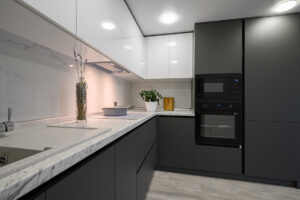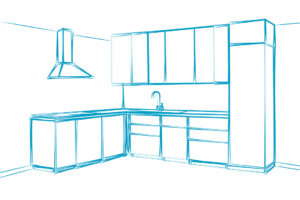 ”The furniture industry is in the process of reinventing itself.
”The furniture industry is in the process of reinventing itself.
The new requirements for an interior design that blurs boundaries call for the development of a new generation of furniture “Modular Kitchen” based on innovative materials, new joining techniques and modular ideas.
There will be a significant increase in demand for furniture that structures spaces and can be used flexibly.”
Claire Steinbrück
Director of imm cologne
Why Modular Kitchen?
Modular kitchen is a collection of multiple furniture pieces and structures that may be combined and arranged in a variety of ways to meet your specific needs.
Modular kitchen compare to the conventional ones, gives you a breath of fresh air as you breathe in the freedom to choose freely, choosing between key characteristics of the modular kitchen composition, colour, and design gives you control like nothing else.
Not to mention the added benefits of shear ease in terms of installation in modular kitchen.
Modular Built-in Furniture
 Your bed can serve as an office as well as the place you go to sleep, similarly these concepts are now valid even for the furniture industry, who would have thought that multifunctional and modular built-in furniture is now the norm to create a modern interior aesthetic that removes fixed boundaries. We take a look at the global trend for boundary-free living.
Your bed can serve as an office as well as the place you go to sleep, similarly these concepts are now valid even for the furniture industry, who would have thought that multifunctional and modular built-in furniture is now the norm to create a modern interior aesthetic that removes fixed boundaries. We take a look at the global trend for boundary-free living.
Modular built-in furniture is in the spotlight when it comes to designing homes which modern and can adapt to any plans that you might have in the future, be it re-arranging the way you live or moving to another home altogether, you will always have the option of your built-in modular furniture following you.
 We have observed people actively transitioning to open kitchens, removing boundaries between the kitchen and the other areas of the home.
We have observed people actively transitioning to open kitchens, removing boundaries between the kitchen and the other areas of the home.
Expansive one-room apartments with modular cabinets, shelving and vanities play it’s role in the blurring of indoor and outdoor areas This indicates that the requirements that we place on the use of our homes are changing.
At the same time, a new need is emerging to restore a degree of privacy, at least temporarily, with flexible boundaries – for instance, to separate the home office or shared spaces. Adaptable furniture systems or room dividers provide solutions for a new form of application-based modularity. But despite all this functionality, there is a growing demand for an overarching language of form in this furniture that fosters a coherent interior aesthetic.
Additionally, built-in cabinet provide storage and free the rooms from an excess of different items of furniture, creating an uncluttered atmosphere that exudes well-being.
This has further compounded benefits if a home has toddlers or children around, avoiding a constant clutter of toys, from the easily accessible shelving and opening systems modular designs have to offer. Standalone built-in furniture positioned freely in the space lends this openness a minimal touch of structure and gives the eye something to fix on.
Modular Office Furniture
 Modular office furniture has also gained significant popularity over office spaces.
Modular office furniture has also gained significant popularity over office spaces.
More companies are seeking and implementing clever ways to make offices fit the modern worker’s needs with modular design – think acoustic panels, storage units and room dividers – which allow employees to use the same space for different needs, producing collaborative and agile spaces that people want to spend time in.
Instead of fixed demarcations, the present day calls for flexible interior concepts that would have been inconceivable and in-constructible in the past.
Advancements in thinking and cultures have brought us to manufacturers responding to the changes in everyday needs with innovative developments that satisfy the desire for freedom.
This trend clearly reveals one thing: Home living is increasingly an expression of individuality and social interaction.

